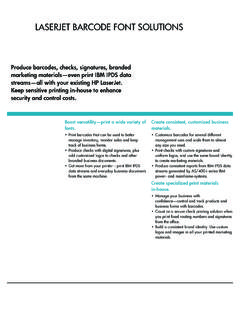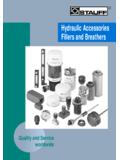Transcription of css Application Note AN555-1 - Custom Silicon …
1 Custom Silicon solutions , Inc. 2008 1 Version , October 2008 cssCustom Silicon solutions , Inc. CSS555(C) Micropower Timer (EEPROM Serial Interface) Overview The CSS555 and CSS555C IC s include an internal memory to store configuration and trim data. The data is stored in a non-volatile memory (EEPROM) so that the information is held even when the device is not powered. A four-wire serial interface provides Read/Write access to the EEPROM. To maintain the standard number of 555 pins, four pins have secondary functions. The alternate functions have been defined so they do not interfere with normal timer operation. The EEPROM includes an internal program voltage generator so no external high voltage signals are required to store new data. The memory access mode is initiated by forcing the CONTROL pin to GND. After the access mode is enabled, the TRIGGER, RESET and OUTPUT pins provide the Serial Clock, Data In and Data Out functions respectively.
2 They are used to enter commands, select an address and input/output data. Each access cycle consists of an eight-bit control byte followed by eight bits of input (or output) data. A detailed description of the pin functions, commands, bit assignments and signal timing is provided in the following figures and tables. A block diagram of the interface circuit is shown below. (see Figure 1) The EEPROM data can be programmed either before or after the device is installed into the system. If programming is done after installation, a simple interface port can be added to the PCB to allow access to the serial interface pins. Several examples are shown in Figures 7-9. Block Diagram Serial Interface Circuit Figure 1 Custom Silicon solutions Inc. 17951 Sky Park Circle, Suite F Irvine, CA 92614 (949) 797-9220 FAX: (949) 797-9225 Control Voltage Reset 5 4 Trigger 2 DIN_EnblOutput Discharge 3 7 In0 In1 OutSel 2:1 Mux Application Note AN555-1 4 4 DOUTData In Register Enbl DIN Clk CMD ADD Command & Address Register Enbl DIN Clk CA_EnblCA_Enbl DIN_Enbl Capacitor Trim EEPROM 555C only EEOUT CT 100pF 8 6 Threshold 8 Configuration EEPROM Control EEOUT DOUT DIN 3 555 Timer & Decade Counter Config In Timer Out Dischg Read EEPROM 6 Trig Control Thresh Reset 555C only Serial Clock Serial Data In Enable EE Access Vsw ~ Clk Sequence Controller Reset EE AddReadStoreCA_EnblDIN_EnblCMD ADD CSS555 IC from Analog Input Pins Custom Silicon solutions , Inc.
3 2008 2 Version , October 2008 CSS555 Micropower Timer (EEPROM Serial Interface) Serial Interface Description Four pins have dual functions to provide Read and Write access to the EEPROM. The CONTROL pin is used to enable the EEPROM programming mode. The voltage at the CONTROL pin (VCONTROL) is normally set to VDD by an internal resistive divider. If VCONTROL is held below , the programming mode is enabled. When the programming mode is active, three additional pin functions are modified to provide the Serial Clock , Serial Data In and Serial Data Out functions. The special pin functions for accessing the EEPROM are listed in Table 1. Pin Function Pin Number Pin Name Primary or Timer Mode Secondary or EEPROM Program Mode 1 VSS GND GND 2 TRIGGER Start Timer Serial Clock 3 OUTPUT Timer Output Pulse Serial Data Out 4 RESET Stop Timer Serial Data In 5 CONTROL Upper Trip Level ( VDD) Program Enable 6 THRESHOLD Upper Comparator Input 7 DISCHARGE CT Discharge FET 8 VDD Positive Supply Positive Supply Table 1 In the programming mode, the serial clock is provided by the TRIGGER pin.
4 The RESET pin becomes Serial Data In and Serial Data Out is provided by the OUTPUT pin. In the normal timing mode, the TRIGGER input is connected to the inverting input of the lower comparator and its switch level is ( VCONTROL). In the programming mode, the TRIGGER input drives a standard CMOS digital input. Its switch level is approximately ( VDD). All access cycles start by forcing the CONTROL pin low and shifting in an eight-bit control byte. (see Figures 2 and 3) The control byte contains a four-bit command and a four-bit address. The command portion is used to specify either a Read or Write cycle. The address portion selects the location to be accessed. A summary of the interface commands is provided in Table 2. If a Read command is entered, the next eight clocks shift the contents of the selected address onto the OUTPUT pin.
5 (Configuration bit assignments are shown in Table 3. Capacitor trim bits (CSS555C only) are entered LSB to MSB.) If a Write command is entered, new data is loaded during the next eight clocks and it is programmed into the EEPROM during the 9th clock pulse. The access cycle is terminated when the CONTROL pin is released. (The internal divider will pull it up to VDD and the normal timer mode will be re-established.) Interface Commands (Control Byte) Control Control Byte MSB LSB Mode Description Pin Address Command Normal 555 Timing mode > xxxx xxxx Read EE1 Read Configuration Data < 0001 0001 Read EE2 (Note1) Read Capacitor Trim Data < 0010 0001 Store EE1 Program Configuration Data < 0001 0010 Store EE2 (Note1) Program Capacitor Trim Data < 0010 0010 Note1: CSS555C only Table 2 Configuration Bits (Data Byte) Counter Configuration MSB LSB Counter Setting (Multiplier) Mode Control MSB LSB Function xxxxx000 1 (Std.)
6 555) xxxx0xxx Astable Mode ( Don t Care if Std. 555) xxxxx001 10 xxxx1xxx Monostable Mode ( Don t Care if Std. 555) xxxxx010 100 xxx0xxxx Micro Power xxxxx011 1K xxx1xxxx Low Power xxxxx100 10K xx0xxxxx Standard Voltage (Trip levels = & VDD) xxxxx101 100K xx1xxxxx Low Voltage (Trip levels = 10% & 90% VDD) xxxxx110 1M Bit 6 Unused xxxxx111 1 (Std. 555) Bit 7 0 if 555, 1 if 555C (Read only) Table 3 AN555-2 Custom Silicon solutions , Inc. 2008 3 Version , October 2008 CSS555 Micropower Timer (EEPROM Serial Interface) Timing Diagrams Read EEPROM (1 Byte) Figure 2 Program EEPROM (1 Byte) Figure 3 Program Byte1, Data = 2B (hex), Read Byte1 Figure 4 AN555-2 Control = 12 hex Data In = 2B hex Enter Data & Program Byte1 1 0 ADD CMD X X Counter Out Counter Out PROGEN Control Pin SCLK Trigger Pin DATA IN Reset Pin DATA OUT Output Pin EE READ Internal Signal EE STORE Internal Signal Store VPP (~20V) Internal Signal Store ~10ms 0 0 1 0 0 0 1 1 1 1 0 0 0 0 Load Data & Program Read Data LSB LSB DATA IN LSB 0 1 ADD CMD 0 0 1 0 0 0 1 1 1 1 0 0 0 0 LSB LSB DATA OUT LSB Control = 11 hex Data Out = 2B hex X Counter Out Read Byte1 X Enter Command & Address Read EE Data Read EE (Configuration or Cap Trim Byte)
7 C2 C3 A0 A1 A2 C1 C0 A3 X X ED2 ED3 ED4 ED5 ED6 ED1 ED0 ED7 Counter Output Counter Output PROGEN Control Pin SCLK Trigger Pin DATA IN Reset Pin DATA OUT Output Pin EE ADDR Internal Buss EE READ Internal Signal EA2 EA3 EA4 EA5 EA6 EA1 EA0 EA7 X Control Byte Data Byte Enter Command & Address Enter New EE Data Enter New EE Data & Program 1 Byte Counter Output Counter Output PROGEN Control Pin SCLK Trigger Pin DATA IN Reset Pin DATA OUT Output Pin EE ADDR Internal Buss EE STORE Internal Signal Store VPP (~20V) Internal Signal Store ~10ms C2 C3 A0 A1 A2 C1 C0 A3 X X ED2 ED3 ED4 ED5 ED6 ED1 ED0 ED7 EA2 EA3 EA4 EA5 EA6 EA1 EA0 EA7 X Control Byte Data Byte Custom Silicon solutions , Inc. 2008 4 Version , October 2008 CSS555 Micropower Timer (EEPROM Serial Interface) Serial Interface Timing Specifications VDD = to , Temperature = -40 C to +85 C Parameter Symbol Conditions Min Typ Max Units Serial Clock Period tCLKP 50% duty cycle 500 200 ns Serial Clock High Time tCLKH Rising to falling edge 250 100 ns Serial Clock Low Time tCLKL Falling to rising edge 250 100 ns Serial Clock Rise/Fall Times tR, tF 20% to 80%, 80% to 20% 100 ns Data In Setup Time tDSU Data valid to rising clock edge 50 25 ns Data In Hold Time tDHD Falling clock edge to data invalid 50 25 ns Mode Lead Time tMLD Control pin low to first clock edge 1000 500 ns Data Output Delay Time tDOD Rising clock edge to Data Out valid 50 100 ns EEPROM Store Time tSTR Clock low time (17th pulse) 25 10 100 millisec Note 1.
8 Typical values are for operation at 3V, 25 C Note 2: Data Output Delay Time (tDOD) measured with CLOAD = 10pF and RLOAD = 1M . Table 4 Serial Interface Timing Diagram Read Mode Figure 5 Program Mode Figure 6 AN555-2 Enter Command & Address (8 clock cycles) Read EE Data (8 clock cycles) CMD0 tMLDEEMODE Control Pin SCLK Trigger Pin DATA IN Reset Pin DATA OUT Output Pin tDSUtDHD tCLKL tCLKH CMD1 tCLKP DOUT0 DOUT1 DOUT2 Timer Out Timer Out tDOD Exit EE Mode Enter Command, Address & Data (16 clock cycles) Store 1 Byte into EEPROM (17th clock pulse) CMD0 tMLDEEMODE Control Pin SCLK Trigger Pin DATA IN Reset Pin DATA OUT Output Pin tDSUtDHD tCLKL tCLKH CMD1 tSTR Timer Out Timer Out Exit EE Mode Custom Silicon solutions , Inc. 2008 5 Version , October 2008 CSS555C Micropower Timer (EEPROM Serial Interface) Serial Interface Examples The CSS555 s serial interface is very straightforward and requires minimal extra components to implement.
9 It consists of three digital input signals that provide control, clock and data input functions and a single digital output that allows data to be read back from the device. The hardware needed to program the EEPROM depends on whether the IC is loose or has been installed in a system. Examples for both conditions are shown in Figures 7, 8 and 9. Programming Before Installation The circuit in Figure 7 shows a diagram for an interface schematic between an ATE (Automatic Test Equipment) and an uninstalled or loose IC. This example allows data to be written to and read from the internal EEPROM. No external components are required for this programming setup. (The timing components RA, RB and C have been omitted.) Figure 7 Program & Read EEPROM Only If the timer function also needs to be tested, the circuit in Figure 8 shows an interface circuit that supports the Read, Write and Timer operating modes.
10 The timing components RA, RB and C have been added. The output driver that provides the VCONTROL signal has been changed to a three-state output buffer. The normal timer mode is enabled when the VCONTROL buffer is disabled (OE=0). This allows the IC to set the voltage level at the CONTROL pin, which is about VDD. A timer cycle is started by pulsing SCLK (Trigger) low. (Reset/Data In must be held high.) Figure 8 Program, Read and Timer Functions Programming After Installation If the CSS555 has been installed into a system, the changes required to implement the serial interface are still relatively minor. An example of one approach is shown in Figure 9. Test points TP1-TP4 have been added to provide access to the TRIGGER, RESET, CONTROL and OUTPUT pins. If three-state buffers are used to generate the test signals, the device can still be operated in the timer mode.






